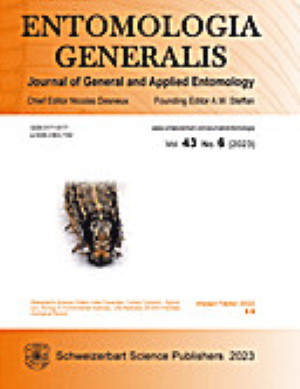亚致死浓度的β-氯氰菊酯通过抑制性信息素的生物合成导致Helicoverpa armigera交配失败
IF 4.6
1区 农林科学
Q1 ENTOMOLOGY
引用次数: 0
摘要
β-氯氰菊酯是一种常用的杀虫剂,用于防治农作物田间的主要农业害虫--胡蜂(Helicoverpa armigera)。本研究调查了β-氯氰菊酯对红蜘蛛交配生理的亚致死效应。结果表明,亚致死接触β-氯氰菊酯会显著减少性信息素的产生,阻碍雌虫吸引雄虫的能力,并降低成功交配的比例。进一步研究发现,亚致死β-氯氰菊酯处理后,性信息素腺体(PGs)中的三卤糖含量明显下降,导致PGs中乙酰-CoA含量随之下降。此外,这种暴露还导致三卤糖转运体、钙神经蛋白酶(CaN)、乙酰辅酶羧化酶(ACC)、蛋白激酶 A(PKA)的 mRNA 表达水平明显下降、信息素生物合成激活神经肽受体 (PBANR)、Δ11-去饱和酶 (DES) 和脂肪酸还原酶 2 (FAR2)的表达水平,以及膜结合脱卤酶、ACC、CaN 和 PKA 的酶活性降低。亚致死暴露降低了雄性信息素结合蛋白1、信息素结合蛋白2和气味受体13的表达水平,表明雄性识别能力下降。总之,亚致死暴露于β-氯氰菊酯会导致性信息素生物合成的前体物质(三卤糖、乙酰-CoA)和酶活性降低,进而导致信息素产量和雌性吸引力降低,雄性检测能力减弱,最终导致交配成功的可能性降低。这项研究加深了人们对亚致死农药暴露如何影响害虫生物学及其作用机制的认识,为将这种影响纳入害虫管理策略提供了依据。本文章由计算机程序翻译,如有差异,请以英文原文为准。
Sublethal concentration of beta-cypermethrin results in the mating failure of Helicoverpa armigera by inhibiting sex pheromone biosynthesis
Beta-cypermethrin is a commonly used insecticide for controlling major agricultural pests as Helicoverpa armigera in crop fields. This study investigated the sublethal effect of beta-cypermethrin on the mating physiology of H. armigera. The results demonstrated that the sublethal exposure to beta-cypermethrin significantly decreased sex pheromone production, hindered female ability to attract males and reduced the proportion of successful matings. Further investigations revealed that trehalose content in the sex pheromone glands (PGs) significantly decreased following sublethal beta-cypermethrin treatment, leading to a subsequent decrease of acetyl-CoA content within the PGs. Furthermore, such exposure caused a significant decrease in mRNA expression levels of the trehalose transporter, calcineurin (CaN), acetyl CoA carboxylase (ACC), protein kinase A (PKA), pheromone biosynthesis-activating neuropeptide receptor (PBANR), Δ11-desaturase (DES) and fatty acid reductase 2 (FAR2), as well as a decrease in the enzyme activities of membrane-bound trehalase, ACC, CaN and PKA. Sublethal exposure lowered the expression levels of pheromone binding protein 1, pheromone binding protein 2 and odorant receptor 13 in males, suggesting decreased male recognition capabilities. Altogether, sublethal exposure to beta-cypermethrin resulted in a decrease in the precursor material (trehalose, acetyl-CoA) and enzyme activities involved in sex pheromone biosynthesis, This, in turn, led to reduced pheromone production and female attractiveness, as well as diminished male detection abilities, ultimately resulted in a lowered likelihood of successful mating. This study enhances knowledge on how sublethal pesticide exposure affects pest biology and their mechanisms of action, providing a basis for including such impact in pest management strategies.
求助全文
通过发布文献求助,成功后即可免费获取论文全文。
去求助
来源期刊

Entomologia Generalis
生物-昆虫学
CiteScore
7.10
自引率
18.80%
发文量
72
审稿时长
>12 weeks
期刊介绍:
Its scope covers all aspects of basic and applied research dealing with insects and more broadly with arthropods inhabiting wild, agricultural and/or urban habitats. The journal also considers research integrating various disciplines and issues within the broad field of entomology and ecology.
Entomologia Generalis publishes high quality research articles on advances in knowledge on the ecology and biology of arthropods, as well as on their importance for key ecosystems services, e.g. as biological control and pollination. The journal devotes special attention to contributions providing significant advances (i) on the fundamental knowledge and on sustainable control strategies of arthropod pests (including of stored products) and vectors of diseases, (ii) on the biology and ecology of beneficial arthropods, (iii) on the spread and impact of invasive pests, and (iv) on potential side effects of pest management methods.
Entomologia Generalis welcomes review articles on significant developments in the field of entomology. These are usually invited by the editorial board, but proposals may be sent to the Editor-in-Chief for preliminary assessment by the editorial board before formal submission to the journal. The journal also considers comments on papers published in Entomologia Generalis, as well as short notes on topics that are of broader interest.
 求助内容:
求助内容: 应助结果提醒方式:
应助结果提醒方式:


